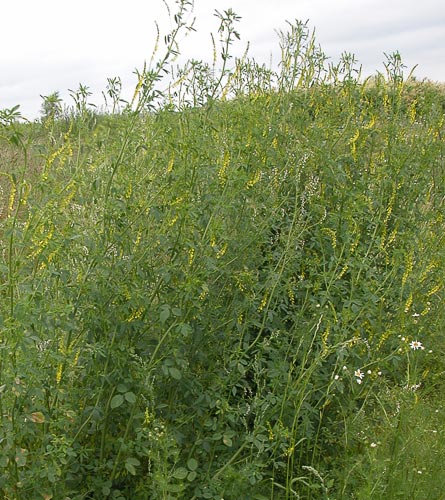Relatives
Melilotus suaveolens Ledeb. - Daghestan sweet clover
Taxonomic position.
Family Leguminosae Endl., genus Melilotus Mill.Biology and morphology.
Biennial or annual herb. Taproot is short with well-developed, lateral branching. Stems erect, thin (4.0-7.0 mm), not very tall (90-110 cm), slightly branched, numerous (10-12). Leaflets of lower leaves obovate, of middle size (2.2-2.5 cm long, 2.0-2.3 wide); leaflets of upper leaves are broadly oval (0.9-1.7 cm) with denticulated margins. Racemes short (7-9 cm), dense; 30-50 flowers per raceme. Flowers are large, 5.0-8.0 mm long and 4.0-8.0 mm wide on average. Single flower stalks are short (1.5-2.0 mm) with anthocyanin color. Corolla is yellowish. Pods are small, 4.0 mm long, with reticulated, ridged coat, ending in sharp, erect, grey point and is one- or two-seeded. Seeds are small, yellowish green, with violet maculation. It has indeterminate flowering. Blossoms in June-September; seeds ripen in July-October. The species is cross-pollinated mainly by honey bees. Chromosome number: 2n=16.Distribution.
This species is distributed throughout the Far East, Western and Eastern Siberia, Kazakhstan and Middle Asia.Ecology.
It grows along rivers, in fields, in meadows, and in sandy and saline soils up to the middle mountain zone in the rigorous continental climate with severe winters.Utilization and economic value.
This is a forage crop that deserves to be cultivated as a very frost-resistant, winter-hardy, nutritive plant. It can be used for pasture and hay, especially in areas with severe winters. Large flowers of the species are very attractive to honey bees; it is a good meliferous plant. It improves soil fertility.Reference citations:
Brezhnev D.D., Korovina O.N. 1980. Wild relatives of the cultivated plants of flora of the USSR. Leningrad: Kolos. 376 pp. (In Russian)Galushko A.I. 1980. Flora of the Northern Caucasus. A field guide. Vol. 2. Rostov-na-Donu. 350 pp. (In Russian)
Grossheim A.A. 1945. Genus Melilotus. Flora of the USSR. Vol. 11. Moscow-Leningrad: USSR. 176-189 p. (In Russian)
Grossheim A.A. 1952. Genus Melilotus. Flora of the Caucasus. Vol. 5. Moscow-Leningrad: Academy of Science of the USSR. 192-194 p. (In Russian)
Hulten E., Fries M. 1986. Atlas of North European Vascular Plants, North of the Tropic of Cancer. Vol. 1-3. Konigstein. 1172 p.
Ovchinnikov P.N., ed. 1978. Flora of Tajikistan. Vol. 5. Leningrad: Nauka. 678 pp. (In Russian)
Pavlov N.B., ed. 1961. Flora of Kazakhstan. Vol. 5. Alma-Ata: AN KazSSR. 515 pp. (In Russian)
Phyodorov A.A., ed. 1987. Flora of the European part of the USSR. Vol. 6. 254 pp. (In Russian)
Polozhiy A.B., Malyshev L.I., eds. 1994. Flora of Siberia. Vol. 9. Novosibirsk: Nauka. 280 pp. (In Russian)
Schischkin V.K., Bobrov E.G., eds. 1945. Flora of the USSR. Vol. 11. Moscow-Leningrad: USSR. 129-176 p. (In Russian)
Schmidt V.M., ed. 1983. Areas of medical plants and their relatives of the USSR. Leningrad: Leningrad University Publishers. 208 pp.
Suvorov V.V. 1950. Genus Melilotus. Flora of cultivated plants of the USSR. Vol. 13. Moscow-Leningrad. Issue 1. 345-502 p. (In Russian)
Vvedenskiy A.I., ed. 1981. Plants of Asia Minor. A field guide. Vol. 6. Tashkent: Fan. 394 pp. (In Russian)


